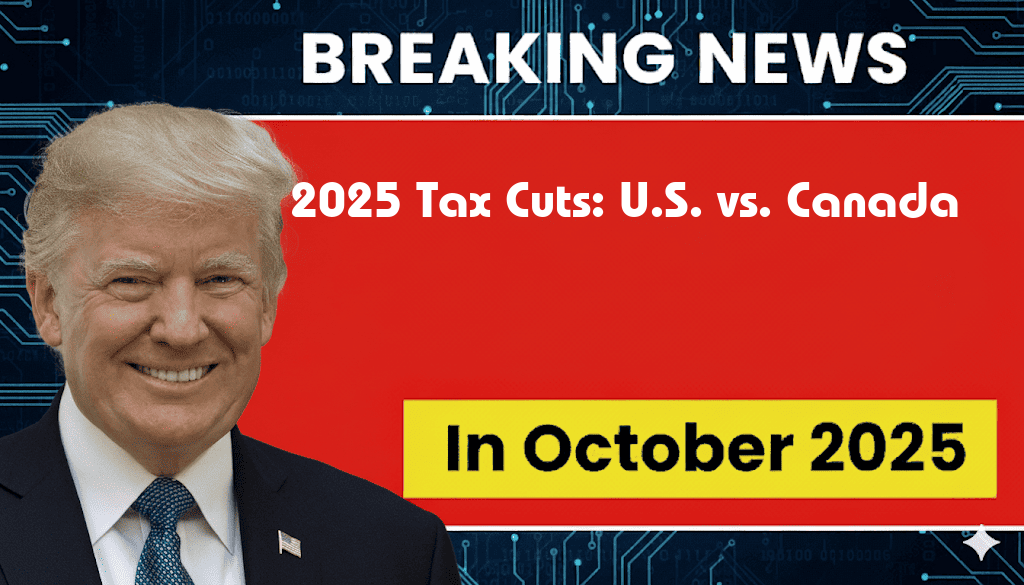2025 Tax Cuts: A Comparative Analysis of $3,752 in the U.S. and C$5,200 in Canada
The tax landscape for 2025 is shaping up to be a critical issue as both the United States and Canada propose significant tax cuts aimed at bolstering their economies. In the U.S., taxpayers can expect an average tax reduction of $3,752, while Canadian residents are looking at an increase of C$5,200 in disposable income due to similar fiscal policies. These proposed cuts reflect the governments’ intentions to alleviate financial burdens on citizens while stimulating economic growth, particularly in the wake of the ongoing recovery from the COVID-19 pandemic. This article offers a detailed comparison of these tax cuts, exploring their implications for taxpayers in both countries and how they might influence consumer behavior and economic stability.
Context and Background
The tax cuts in both the U.S. and Canada come amid a backdrop of inflationary pressures and rising living costs. Policymakers in both nations are responding to public demand for economic relief as inflation rates have surged, affecting the purchasing power of everyday citizens. The proposed tax adjustments are seen as a strategic move to provide immediate financial relief and foster longer-term economic growth.
Understanding the U.S. Tax Cuts
In the United States, the tax cuts for 2025 are part of a broader fiscal strategy aimed at reducing the tax burden on middle-class families and small businesses. The average reduction of $3,752 is expected to come from various sources, including:
- Increased standard deductions.
- Revised tax brackets that favor lower-income earners.
- Enhanced credits for families with children.
This approach is designed to provide immediate relief while encouraging consumer spending, which is crucial for economic recovery. The potential impact of these cuts could be substantial, as increased disposable income may lead to higher consumption rates, benefiting local businesses.
The Canadian Perspective
Conversely, Canada’s proposed tax cuts are slightly more aggressive, with an average increase of C$5,200 in disposable income for taxpayers. The Canadian government is focusing on:
- Raising the basic personal amount, allowing individuals to earn more income tax-free.
- Targeted tax credits for specific sectors, including green energy and technology.
- Increased support for families, particularly those with children in childcare.
This strategy is intended not only to ease the financial strain on families but also to stimulate sectors deemed essential for long-term growth, such as renewable energy and technology innovation.
Comparative Analysis
| Feature | United States | Canada |
|---|---|---|
| Average Tax Cut | $3,752 | C$5,200 |
| Primary Benefit Focus | Middle-class and small businesses | Families and targeted sectors |
| Key Changes | Standard deductions, tax brackets | Basic personal amount, sector-specific credits |
Economic Implications
The economic implications of these tax cuts are substantial for both nations. In the U.S., the projected increase in disposable income might lead to heightened consumer spending, which, in turn, could drive demand and stimulate job growth. According to a report by Forbes, such tax relief often correlates with increased investment in local businesses and infrastructure.
In Canada, the focus on specific sectors may yield a more targeted approach to economic recovery. By investing in green technologies and childcare, the government aims to create sustainable growth patterns that align with long-term environmental goals. This strategy not only provides immediate relief but also positions Canada as a leader in sustainable economic practices.
Conclusion
The proposed tax cuts for 2025 in both the U.S. and Canada reflect a shared commitment to economic recovery amidst challenging times. While the figures may differ, the underlying goal remains the same: to enhance the financial well-being of citizens and stimulate economic growth. As these policies unfold, both governments will be closely monitoring their effectiveness, with the hope of paving the way for a more stable financial future.
Frequently Asked Questions
What are the main differences between the 2025 tax cuts in the U.S. and Canada?
The 2025 tax cuts reflect a significant disparity, with the U.S. seeing a reduction of $3,752 and Canada benefiting from a larger cut of C$5,200. These differences stem from varying tax structures and government policies in the two countries.
How do the 2025 tax cuts impact individuals in the U.S.?
The $3,752 tax cut in the U.S. is designed to provide relief to middle-class families, potentially increasing disposable income and stimulating economic activity.
What factors contribute to the larger tax cut in Canada?
The larger C$5,200 tax cut in Canada can be attributed to different fiscal strategies, including higher income tax rates that allow for greater reductions, as well as a focus on social programs that aim to support citizens directly.
Will these tax cuts affect the overall economy in both countries?
Yes, both the U.S. and Canadian tax cuts are expected to influence their respective economies by increasing consumer spending and potentially leading to job growth as businesses respond to increased demand.
How can individuals stay informed about changes to tax policies in 2025?
Individuals can stay informed about tax policy changes by following updates from government websites, consulting financial advisors, and participating in community forums that discuss fiscal matters.

Leave a Reply